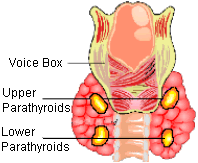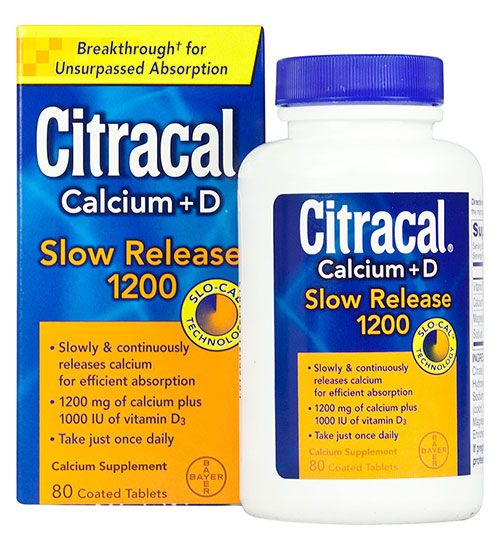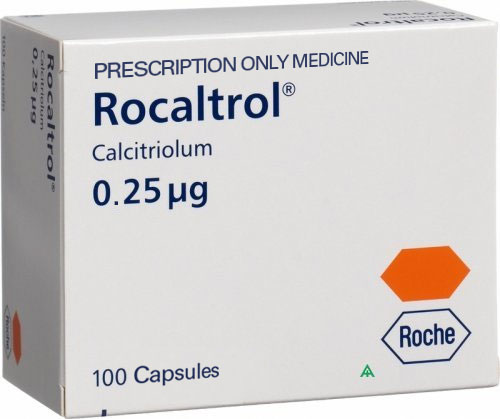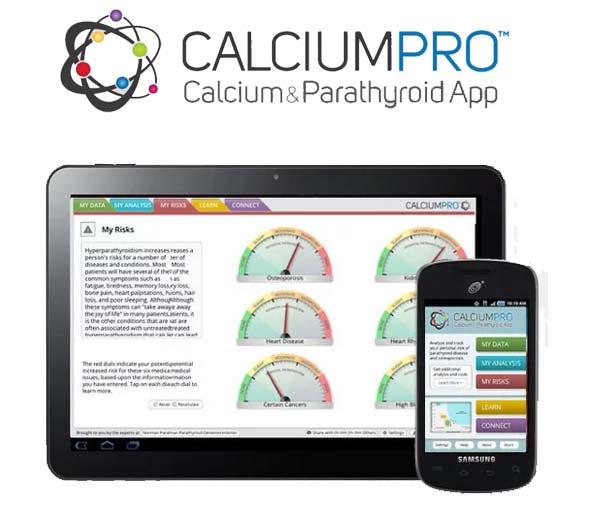Hypoparathyroidism is the combination of symptoms due to inadequate parathyroid hormone production (PTH) (Hypo-parathyroid-ism). This is a very rare condition, and almost always occurs because of damage or removal of parathyroid glands at the time of parathyroid or thyroid surgery. This bears repeating: When people have too little parathyroid hormone (PTH), it is almost always because they had thyroid or parathyroid surgery and all four parathyroid glands were removed or injured. This is a mistake by the surgeon and is not supposed to happen. If this is the first parathyroid page you have read from our site, we strongly recommend that you read our introduction to the parathyroid gland first! Remember, hypER-parathyroidism is MUCH more common than hypOparathyroidism.
 Hypoparathyroidism is the state of decreased secretion or decreased activity of parathyroid hormone (PTH). This lack of PTH leads to decreased blood levels of calcium (hypocalcemia) and increased levels of blood phosphorus (hyperphosphatemia). There are no symptoms of too little parathyroid hormone other than the symptoms due to having a blood calcium that is too low. This bears repeating... the symptoms are due to the lack of calcium in the blood, not a lack of PTH. Of course its the lack of PTH that causes the lack of calcium in the blood.
Hypoparathyroidism is the state of decreased secretion or decreased activity of parathyroid hormone (PTH). This lack of PTH leads to decreased blood levels of calcium (hypocalcemia) and increased levels of blood phosphorus (hyperphosphatemia). There are no symptoms of too little parathyroid hormone other than the symptoms due to having a blood calcium that is too low. This bears repeating... the symptoms are due to the lack of calcium in the blood, not a lack of PTH. Of course its the lack of PTH that causes the lack of calcium in the blood.
The symptoms of hypoparathyroidism are synonymous with hypocalcemia and can range from quite mild (tingling in the hands, fingers, and around the mouth) to more severe forms of muscle cramps leading all the way to tetany (severe muscle cramping of the entire body), and convulsions (this is very rare!). This will make sense when you remember that calcium has several main functions in our bodies including 1) providing the electrical energy for all of our nervous system, 2) providing the electrical energy for muscle contraction, and 3) providing strength to our bones. All of the symptoms of hypocalcemia are due to dysfunction of our nerves (primarily) and our muscles (to a lesser extent).
Causes of Hypoparathyroidism
Parathyroid gland insufficiency is quite rare, but it can occur in three well defined ways discussed below. As stated above, the most common cause of hypoparathyroidism is the loss of parathyroid tissue following thyroid or parathyroid surgery by a surgeon with too little experience.
Three Categories of Hypoparathyroidism (each discussed below)
- Deficient Parathyroid Hormone (PTH) secretion. (>99% of all cases)
- Inability to make an active form of parathyroid hormone. (extremely rare)
- Inability of the kidneys & bones to respond to the parathyroid hormone being produced by normal parathyroids. (extremely rare)
[1] Deficient Parathyroid Hormone Secretion.
This type of hypoparathyroidism is the easiest to understand, and it accounts for more than 99% of ALL patients with too little parathyroid hormone. Yep, almost 100% of patients with hypoparathyroidism have this exact problem. A patient afflicted with this condition simply has too little (or a complete absence of) parathyroid tissue, therefore inadequate parathyroid hormone is produced. This is almost ALWAYS due to a complication of thyroid or parathyroid surgery.
The reason that there is too little parathyroid tissues is because all of the parathyroid glands were (unintentionally!) removed at the time of surgery. The operation that is typically associated with this problem is the 'Old-Fashioned Standard Parathyroid Operation', or a total thyroidectomy. Parathyroid surgery (and to a lesser extent) can be very tricky, with the results being extremely dependant upon the experience of the surgeon. Hypoparathyroidism occurs when an inexperienced surgeon removes all four parathyroid glands, or removes a couple and kills the remaining one(s) because they were not careful enough. Remember, a normal parathyroid gland is the size of a grain of rice and it has a single artery and vein that keeps it alive. This artery and vein are usually about the size of a human hair. So, if the surgeon isn't experienced with the proper handling of these delicate glands, he/she will kill them and the patient will suffer. We have an entire page on this topic... surgeon-induced hypoparathyroidism.
The most common disease of the parathyroid glands is hypERparathyroidism, where one of the parathyroid glands grows into a tumor and produces too much parathyroid hormone (PTH). The only treatment for this disease is surgery and the goal of this operation is to remove the parathyroid gland that is overproducing PTH. However, the inexperienced surgeon will occasionally remove too many parathyroid glands (or kill the ones they don't remove) and the patient is left with hyp0parathyroidism. Recent studies by our group (and many other studies over the past 30 years) shows that hypOparathyroidism occurring after an operation for hypERparathyroidism happens when the surgeon does less than 50 parathyroid operations per year. Thus, no matter where you read about parathyroid disease, you are told to find a VERY experienced surgeon. If you are reading this and you have hyp0parathyroidism, I can almost guarantee that you were referred to some surgeon that does all sorts of operations... but this surgeon does not do more than 1 of these operations per Week (<10 per year, probably less). This is why you are suffering.
The second operation which is associated with postoperative hypoparathyroidism is a total thyroidectomy. This operation is performed for a number of reasons, but because of the close relationship that the thyroid and parathyroid have to one another (including sharing some of the same blood supply) the parathyroid glands can be injured or removed. This is rare and occurs in less than 1% of thyroid operations. In many patients, the inadequate secretion of parathyroid hormone is transient following surgery on the thyroid or parathyroid glands, so this diagnosis cannot be made immediately following surgery. (This is an important point!). It takes a few months after surgery to determine if you have PERMANENT hypoparathyroidism--but sadly, if you have this right after surgery, you have about a 75% chance that it will be a permanent problem.
Often, hypOparathyroidism following thyroid or parathyroid surgery will be temporary (a month or two). This almost always occurs during the old-fashioned parathyroid operation where all four parathyroid glands are biopsied. As noted above, these little guys are very fragile and manipulating them so that 1/3 to 1/2 of each of them can be cut off for a biopsy can be very stressful. Occasionally this manipulation will kill the gland. Sometimes it causes a blood clot inside the gland that makes the gland not work for a month or two. If you have hypoparathyroidism after thyroid or parathyroid surgery--do not assume that it is permanent until at least 3 months after the operation. If the glands are simply traumatized then they will recover and start working within this time period. If 3-4 months goes by and you are still hypOpara, then you are likely to be this way for ever.
We get at least 2 calls per week from patients who have hypoparathyroidism because their surgeon removed too many parathyroid glands during their parathyroid surgery. PLEASE PICK YOUR SURGEON CAREFULLY!
[2] Inability to Make Active Parathyroid Hormone.
Deficient PTH secretion without a defined cause (e.g. surgical injury) is termed Idiopathic hypoparathyroidism. This disease is rare and can be congenital or acquired later in life. This is a very rare form of a very rare disease!!
- Congenital
- Patients in this category are born without parathyroid tissues. Most patients with congenital hypoparathyroidism have no family history of the disease. Those who do may have any one of a number of congenital causes. The pattern of inheritance is as varied as the kinds of genetic abnormalities that cause the disease. The children in some families are at a 50% risk for disease (dominant gene defect) while others are at a risk of 25% or less (recessive gene defect). In some families only the boys suffer from a lack of parathyroid tissue. This sex-linked inheritance pattern indicates the presence of a genetic defect on the X chromosome. The inherited forms tend to arise from abnormal genes that either: 1) encode abnormal forms of PTH or its receptor, 2) prevent normal conduction of cell signals from the PTH receptor to the nucleus, or 3) prevent normal gland development before birth.
- Hypoparathyroidism with onset during the first few months of life can be permanent or temporary. The cause is either "unknown" or because mom had hyperparathyroidism (see below). Occasionally spontaneous resolution occurs. If it does not, it will usually become manifest by 24 months of age.
- The biggest cause of congenital hypoparathyroidism occurs in babies born to mothers who had severe hyperparathyroidism during pregnancy. Blood calcium in the baby will be exactly the same as it is in the mother, and if the calcium is too high during the the entire pregnancy, the normally developing parathyroid cells in the baby will sense the high calcium and decide not to grow and reproduce. Thus, these babies can be born with very small and underdeveloped parathyroid glands--or they can be born with normal parathyroid glands that are just dormant. Typically, the baby will develop parathyroid glands normally but they will be suppressed at birth (normal parathyroid glands shut down and become dormant in the presence of high calcium)... thus the baby is born with high calcium like mom, but parathyroid glands that are dormant. This will not result in permanent parathyroid gland dysfunction in the child but any baby born to a mother with hyperparathyroidism must be monitored for low calcium for the first few days after birth. The baby will seem fine for the first day because they have lots of mom's calcium in their blood. Then they can get tetany and have convulsions on the second or third day of life because their calcium goes too low (typical symptoms of severe hyp0para). For more information, read our section on Hyperparathyroidism During Pregnacy.
- Acquired
- The acquired form of this disease typically arises because the immune system has developed antibodies against parathyroid tissues in an attempt to reject what is sees as a foreign tissue, much as it would a transplanted organ. This disease can affect the parathyroid glands in isolation or can be part of a syndrome that involves many organs. An antibody that binds to the calcium sensor in the parathyroid gland has been discovered in the blood of patients with autoimmune hypoparathyroidism. It has been proposed that such binding "tricks" the parathyroid gland into believing that the blood level of ionized calcium is high. Responding to this signal, the parathyroid stops making PTH.
- Acquired due to Hypomagnesemia
- The element magnesium is closely related to the action of calcium in the body. When magnesium levels are too low, calcium levels may also fall. It appears that magnesium is important for parathyroid cells to make PTH normally. Once recognized, this is usually very easy to fix. Chronic alcoholism is a frequent cause of low calcium and magnesium levels which can lead to secretion of Biologically Inactive Parathyroid Hormone.
- PLEASE NOTE: This section is placed here for completion sake only. There have only been a few cases of any of these syndromes ever reported, but one can see that if the PTH which is produced is actually a defective hormone, it would not have the same biologic strength as its normal counterpart. Remember, well over 99 percent of patients with too little parathyroid hormone have the problem because of the removal of too much parathyroid hormone during an operation on their thyroid or parathyroid glands.
[3] Resistance to Parathyroid Hormone (pseudo-hypoparathyroidism).
This disease is also VERY RARE! Like all patients with hypoparathyroidism, this disease is characterized by hypocalcemia (too low blood calcium levels) and hyperphosphatemia (too high blood phosphorus levels), but they are distinguished by the fact that they DO produce NORMAL parathyroid hormone. The problem is that their bones and kidneys do not respond to the parathyroid hormone. Even if normal parathyroid hormone is given to them in their veins, they do not respond to it...the problem lies in the bones and kidneys. Therefore, these rare individuals have plenty of PTH, but their organs do not behave appropriately to it (so they look to be hypoparathyroid but they are not...thus the name "pseudo-hypoparathyroid").
Treatment of Hypoparathyroidism
 Vitamin D and calcium supplements are the primary treatments for this form of hypoparathyroidism regardless of the cause. The only exception is when the inactivity of parathyroid hormone is due to hypomagnasemia which is readily treated with magnesium supplementation. At this time, a replacement form of parathyroid hormone (PTH) is not available to give to people who have had their parathyroids removed during a neck operation.
Vitamin D and calcium supplements are the primary treatments for this form of hypoparathyroidism regardless of the cause. The only exception is when the inactivity of parathyroid hormone is due to hypomagnasemia which is readily treated with magnesium supplementation. At this time, a replacement form of parathyroid hormone (PTH) is not available to give to people who have had their parathyroids removed during a neck operation.
CALCIUM: There are several calcium brands and types available on the market. Some will work better for some people while another brand will work better for others. When patients need lots of calcium because of their lack of functioning parathyroid glands I usually recommend that they take 2 different brands (e.g., Citracal and Oscal) that are different types of calcium (calcium citrate and calcium carbonate, respectively). Taking lots of one type often will give a patient problems with their GI tract (diarrhea, or more commonly, constipation).
 ROCALTROL: There is one primary brand of Vitamin D that endocrinologists prescribe: Rocaltrol (also known by its generic name calcitriol) -- a synthetic, man-made Vitamin D produced by Roche Pharmaceuticals. Since parathyroid hormone (PTH) is necessary for the kidney to manufacture the active form of Vitamin D--and patients with hypoparathyroidism don't have PTH, these patients do not make enough vitamin D. And, since Vitamin D is needed to help absorb calcium in our intestines, it doesn't make much sense to give patients with hypoparathyroidism lots of calcium pills without giving them Vitamin D. Thus, virtually all patients with hypoparathyroidism are on both calcium and Rocaltrol.
ROCALTROL: There is one primary brand of Vitamin D that endocrinologists prescribe: Rocaltrol (also known by its generic name calcitriol) -- a synthetic, man-made Vitamin D produced by Roche Pharmaceuticals. Since parathyroid hormone (PTH) is necessary for the kidney to manufacture the active form of Vitamin D--and patients with hypoparathyroidism don't have PTH, these patients do not make enough vitamin D. And, since Vitamin D is needed to help absorb calcium in our intestines, it doesn't make much sense to give patients with hypoparathyroidism lots of calcium pills without giving them Vitamin D. Thus, virtually all patients with hypoparathyroidism are on both calcium and Rocaltrol.
FORTEO (teriparatide). Forteo is a genetically engineered man-made hormone that is composed of the first 34 amino acids of the human PTH molecule (about 1/2 of the molecule, but it works like the entire molecule). Lily is the pharmaceutical company that makes this hormone and their name for this is "Forteo" (the generic name for this hormone molecule is "teriparatide" (tare-ree-PAIR-ah-tide)). Because this molecule is a hormone (a protein with a very specific size and shape), it must be given with a shot under the skin just like insulin. And, like most other hormones, it has a short lifespan in the body (half-life) so that it needs to be given at least once per day. In fact, some would suggest that taking the shots twice per day will work better and use less hormone than taking it once per day. A lot of hypOparathyroid patients are now taking Forteo or have tried it in the past to help them cope with the loss of their own parathyroid glands. Some patients have found that it makes their disease much more manageable, wile others simply say that the drug makes them feel worse or doesn't help at all. It is important to remember... there is not much known yet about using this drug for hypOparathyroidism, as no good medical studies have been done yet. This drug was made for the treatment of osteoporosis in post-menopausal women (this is a MUCH BIGGER market for the drug companies than is the rare condition of hyp0parathyroidism). It is used in post-menopausal women who are at high risk of having fractures, have had fractures, or who cannot use other osteoporosis treatments. This medicine increases bone mass and bone strength, thereby decreasing the chance of getting a fracture. HOWEVER, for patients with hyp0parathyroidism, the issue is to replace the hormone that has been removed with the parathyroid glands. Lilly will still be using this drug for severe cases of osteoporosis, but for now the use of this drug in patients with hyp0parathyroidism is at the discretion of your endocrinologist, provided the endocrinologist tells you about the potential risks of this drug (some tests showed that this drug caused bone cancer in the lab animals that they were giving it to). Although the doses of the hormone that they were giving to the experimental animals was MUCH higher than would be given to a human for hyp0parathyroidism, it did cause the bone cancer so Lilly stopped the clinical trials in humans with hypoparathyroidism). This does not mean that you should not take this drug... but it is not FDA approved for use in hypoparathyroidism. I regularly recommend this drug for patients with hypoparathyroidism that are referred to me--and if the patient feels that the drug helps, then I recommend they stay on it. There are some very specific patients that should never take Forteo (those at risk for osteosarcoma: e.g. Paget's disease, prior radiation therapy, bone metastases, open epiphyses, etc). As a side note, Dr Norman is NOT a fan of Forteo for osteoporosis. He's not sure it actually works and thinks most doctors who give it have no idea what they are doing. This is an editorial, and an opinion based on observations but not on actual studies.
IMPORTANT. If you are one of the rare patients that has had all your parathyroid glands removed and a part of one transplanted in your arm (almost never appropriate for primary hyperparathyroidism, but done regularly for hyperparathyroidism due to renal failure) and you have hypoparathyroidism immediately after the surgery... you should NOT take Forteo in the first 3-4 months. It is possible that your transplant will begin to make hormone after a few months... but if you take Forteo you could suppress the parathyroid cells that are trying to grow and doom your transplant. If the transplant is making little or no parathyroid hormone after 4 months, it will likely never make sufficient (any??) hormone and Forteo may be tried. You can read more about Forteo here.
Parathyroid Gland Transplantation. Not a week goes by that we don't get an email from a patient with hypoparathyroidism that asks us if it is possible to transplant a healthy parathyroid gland from some other donor into their body so their hypoparathyroidism would go away. This sounds wonderful, especially since all of us have 4 parathyroid glands... 3 of which we don't really need. But, the sad truth is that endocrine cells are very highly vascular and transplants from one individual to another will be rejected by our immune system. The only exception is between identical twins (I have done this successfully). The confusion comes from patients reading about parathyroid auto-transplantations--which is where one parathyroid gland is taken out of a patient's neck and then transplanted somewhere else in that same individual (often put into a muscle in the arm so it is easy to get to if it ever goes bad). Parathyroid auto-transplantation is routinely done for patients with secondary hyperparathyroidism due to renal failure in patients on dialysis. It should almost never be done for patients with primary hyperparathyroidism. Now we've come full circle--the worst cases of hypOpara occurs when a patient with primary hyperparathyroidism has all their parathyroid glands removed and one of them autotransplanted (put into one of their muscles). This patient would have been better served with simply removing 3.5 glands. Experienced surgeons would almost surely not do this and thus, don't cause hyp0para when they are operating for hypERpara. YOU MUST CHOSE YOUR SURGEON WISELY!
What's New? A New Clinical Trial of a New Drug... ?
There is clinical trial of a new parathyroid drug (it is actually part of the PTH molecule) that is being tested in people with hypoparathyroidism. This study is being conducted by friends of ours at the National Institutes of Health (the NIH) in Washington, DC. If you have hypoparathyroidism you should contact them to see if you qualify for their clinical trial of this new drug. If you click on these two links you can read more about the study and contact our friends Dr Rachel Gafni and Dr Michael Collins to see if this trial is appropriate for you.
www.hypoparathyroidstudy.com or www.hypoparathyroidstudy.org
The home page lists the eligibility criteria--it helps determine who can enter the trial. In short, the study is looking at the skeletal effects of PTH 1-34 replacement therapy in adults with hypoparathyroidism. They will receive PTH therapy for up to 5 years and undergo two iliac crest bone biopsies. The theory is that taking some of this PTH will help prevent some of the bone problems that is commonly seen in patients who have no parathyroid hormone. When you contact them, tell them we said "hello!".
New If you want to read more about surgeon-caused hypoparathyroidism, then read the results of the world's largest study of these patients conducted by Dr Norman along with the Hypoparathyroid Association of America. This excellent study is on a different page.
IMPORTANT: If you are reading these pages because you or someone you know is contemplating parathyroid surgery, then please read the page on Cure Rates and Complication Rates for different types of parathyroid surgery. This page shows how the experience of the surgeon has a great bearing on how often a patient develops a problem such as hypOparathyroidism. It also shows how mini-parathyroid surgery has a near zero chance of causing hypoparathyroidism. Pick your surgeon well! A bad result after parathyroid surgery can be really bad.




